Mountain (Associated spots)
Introduction to associated facilities

Musashi Mitake-Jinja Shrine
- Ome City
- The culture of the Tama area
Musashi Mitake-Jinja Shrine is located on the summit of Mitake-san Mountain. It is said that it was built during the reign of Emperor Sujin. When shrines and temples became popular during the Edo period, the faith of Mitake-Jinja Shrine spread throughout the Kanto region. The wolf that was the messenger of Mitake Okami (Mitake God) was derived from the legend that when Yamato Takeru-no-mikoto lost his way in this area a long time ago, he was led by the wolf and escaped his predicament.
Currently the shrine also prays for dogs, and so it is a popular shrine visited by many worshipers with their dogs. There is also the treasure repository in the precinct, which contains two national treasures including “Akaito-odoshi-yoroi armor” (along with four other important cultural properties) and is said to have dedicated by the military commander Hatakeyama Shigetada according to the history of the Edo Period. The “Murasaki-susogo-Kacchu armor” which is an important cultural property, is the armor that Yamato Takeru-no-mikoto is said to have dedicated and then written an order to the district “to store the armor” which was read as “Musashi”. This is the origin of the place name “Musashi”.
176 Mitakesan, Ome City, Tokyo 198-0175
TEL. 0428-78-8500
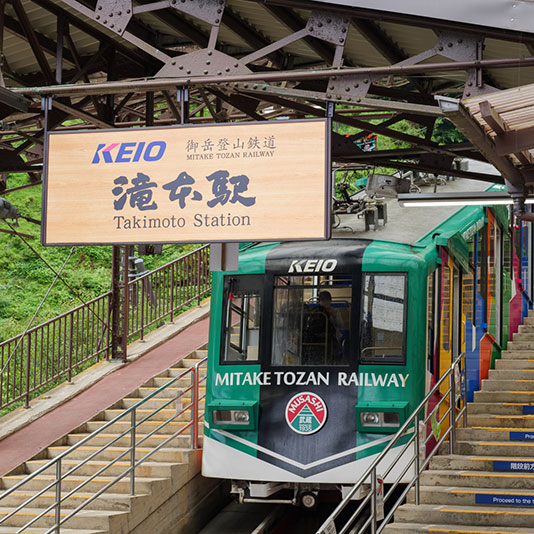
Mitake Tozan Railway
- Ome City
The Mitake-san Cable Car, which connects the foot of Mitake-san Mountain to its summit, was founded in 1927. It is an indispensable means of transportation for people who live on Mitake-san Mountain, such as Shukubo (pilgrim’s lodging) and shrines near the summit, as well as those who visit for sightseeing and mountain hiking. Riders are thrilled by the steep slope with an average grade of 22 degrees and a maximum of 25 degrees, while looking at the scenery of Mikake-san Mountain. They can arrive at the summit in no time at all as it takes only 6 minutes from Takimoto Station at the foot of the mountain to Mitake-san Station at an altitude of 831m. In the shops at Mitake-san Station you can find many unique souvenirs such as mountaineering equipment and local crafts.
Address: 2-483 Mitake, Ome City, Tokyo 198-0174
TEL. 0428-78-8121
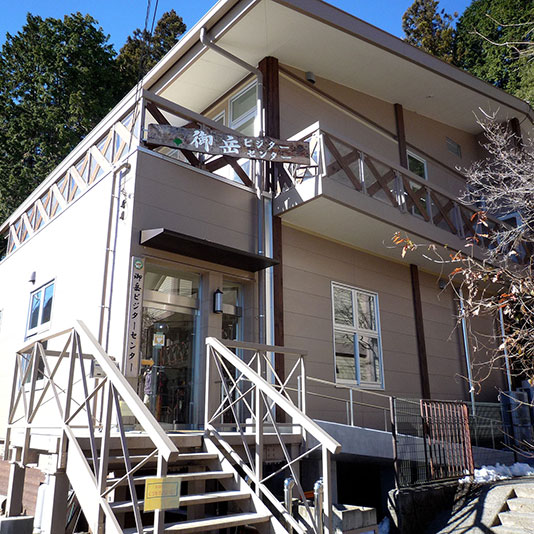
Mitake Visitor Center
- Ome City
The Mitake Visitor Center is about a 10-minutes walk from Mitake-san Station on the Mitake Cable Car. This facility introduces the nature, animals and plants of Mitake-san Mountain to those visiting. A resident interpreter guides you to recommended mountain hiking routes and highlights for each season, information on what is flowering, and points out where cute flying squirrels live. In the Visitor Center, items such as stuffed animals and plants are displayed and activities where you can enjoy crafting experiences using nuts are also provided in the building. The latest information on Mitake-san Mountain is also posted on our website and social media. This is the facility you definitely want to stop by to enjoy Mitake-san Mountain.
38-5 Mitake-san, Ome City, Tokyo 198-0175
TEL. 0428-78-9363

Higashi-baba
- Ome City
Higashi-baba, located on the approach to Musashi-Mitake Jinja Shrine, built in 1886 is a Shukubo (pilgrim’s lodging). It features a thatched roof that conveys the appearance of the Edo period as it was. It is a historic building with tatami rooms decorated in the Shoin-zukuri style, an inner temple for religious ceremonies, a restroom and a private study which were used in Edo peiod. It is registered as a cultural property of the residence “Babake-oshi-Jutaku” designated by the Tokyo Metropolitan Government. Only one group per day can stay there and it can be used as a lunch or teahouse.
54 Mitake-san, Ome City, Tokyo 198-0175
TEL. 0428-78-8446
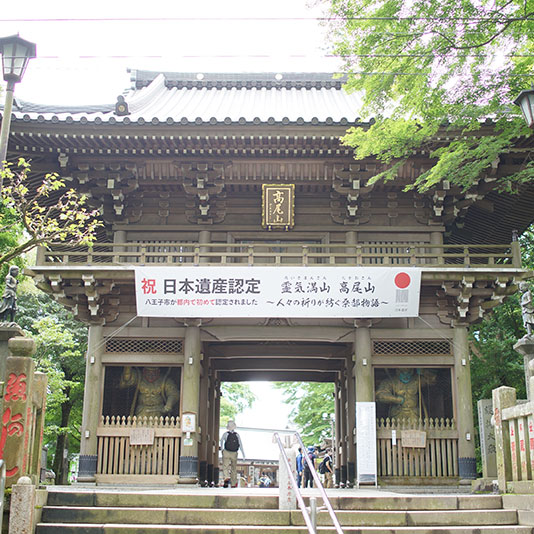
Takao-san Yakuo-in Temple
- Hachioji City
- Culture of the Tama area
“Takao-san Yakuo-in Temple” is located on the mountainside of Takao-san Mountain at an altitude of 599m. It was opened in 744, about 1270 years ago, by the high priest Gyogi Bosatsu, who received the edict of Emperor Shoumu. It is now known as the head temple of Shingon-shu Chizan-ha (a form of Buddhism in Japan). The principal image of worship is “Izuna-daigongen (a syncretistic fusion of Shintoism and Buddhism)”. Its feature is an incarnation of Fudomyo-o, which means a guardian deity that does not move, and is characterized by the combination of five gods and Buddha. The legend of the Tengu (long-nosed goblin) has been told on Takao-san Mountain for a long time, and it is said that the Tengu is the guardian of “Izuna-daigongen” and plays a role in bringing good luck and amulets. There are many statues of Tengu and statues with Tengu motifs in the surrounding precincts, so please look for them.
2177 Takao-machi, Hachioji City, Tokyo 193-8686
TEL. 042-661-1115
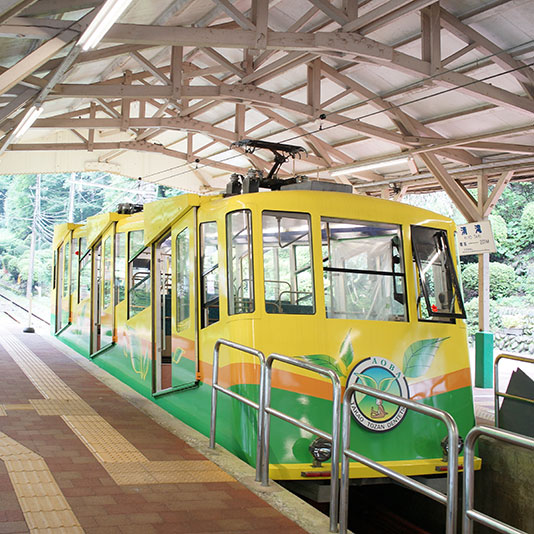
Takao-san Mountain Railway
- Hachioji City
The Takao-san Mountain Railway Cable Car has a long history as it was first opened in 1927. During the war, it was temporarily suspended, but resumed operations in 1949. Since then, it has been popular as a means of transportation for visitors to Takao-san Mountain. It takes about 6 minutes to get to 271m above sea level from Kiyotaki Station at the foot of Takao-san Mountain to Takao-san Mountain Station on the mountain’s lower slopes. The highest gradient reaches 31 degrees, making it the steepest cable car in Japan, and the ride lasts for 18 minutes. From the window of the cable car, you can enjoy seeing not only the nature of Takao-san Mountain, but also the skyscrapers of Shinjuku area and the Tokyo Sky Tree on a clear day. We also recommend the lift if you want to enjoy the view of Takao-san Mountain while feeling the breeze. This way you can access the mountaintop while enjoying the view of the changing seasons. Especially in summer, the wind feels good and it is perfect for keeping cool.
2205 Takao-machi, Hachioji City, Tokyo 193-8511
TEL. 042-661-4151
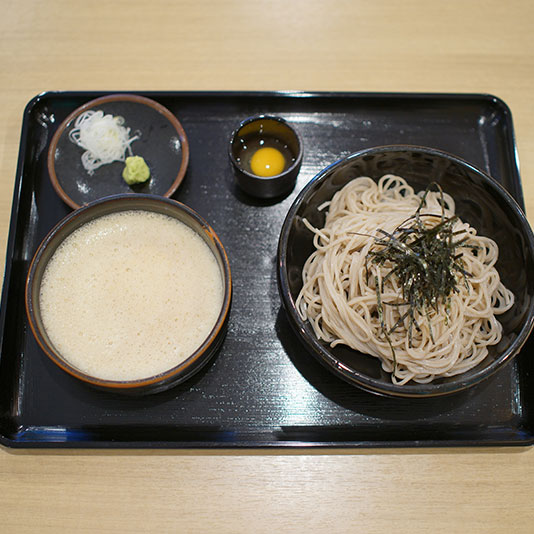
Momijiya-honten (Restaurant)
- Hachioji City
- Gourmet
“Tororo Soba (Japanese noodles with grated yam)”, one of Takao-san Mountain’s specialty gourmet dishes is used to provide nutritious natural yam with soba to heal the tiredness of worshipers visiting Yakuo-in. It is said to have been popular here first and then spread its popularity outward. Therefore, there are many soba restaurants from Takao-san Station along the Keio Line to the entrance of the mountain trail. The most popular restaurant of these is Momijiya-honten, which was founded in 1897. Their popular menu “Tororo Soba (with quail eggs)” is characterized by its pure white and fluffy tororo (grated yam). When grating the yam only the central part of the yam with is used. When eating tororo with moderately chewy soba, the rich taste spreads in your mouth, and it is recommended that the quail eggs be mixed with the tororo.
2208 Takao-machi, Hachioji City, Tokyo 193-0844
TEL. 042-661-2012
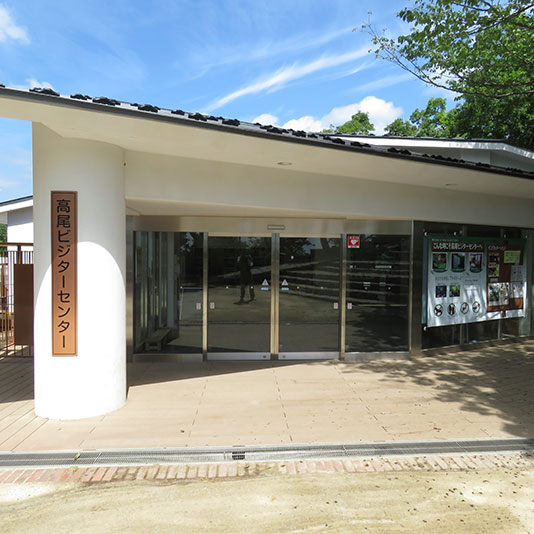
Takao Visitor Center
- Hachioji City
The Takao Visitor Center on the summit of Takao-san Mountain is a facility that provides information on local nature such as animals and plants that inhabit the Takao-san Mountain area, and an introduction of the historical culture and information on mountain trails. Opened in 1969, it is also the first visitor center in Japan where an interpreter permanently resided. In this center, where you can enjoy learning the history and nature of Takao-san Mountain there are panels of information on the mountain trails along with stuffed animal and plants on display. At the information counter you can ask and resolve any kind of question regarding Takao-san Mountain. You can also enjoy annual events which can provide nature experience and outdoor programs, and you can learn about nature while walking in the forest of Takao-san Mountain with the interpreter.
2176 Takao-machi, Hachioji City, Tokyo 193-0844
TEL. 042-664-7872
Introduction to tourist spots
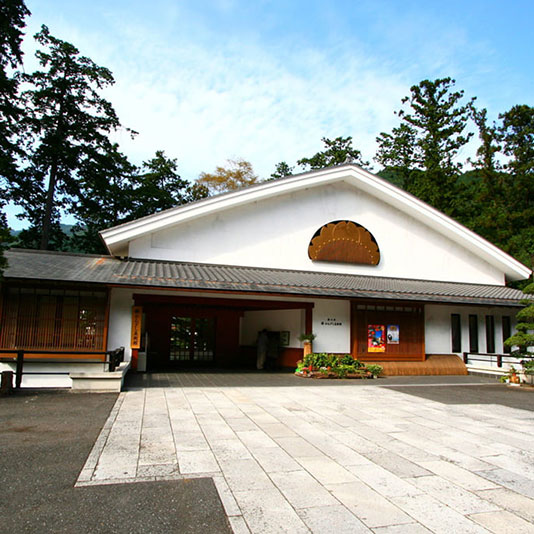
Kushi Kanzashi Museum (Combs & Ornamental Hair Pins Museum)
- Ome City
- Culture of the Tama area
The Kushi Kanzashi Museum displays beauty products used by women from the Edo period to the Showa period. Approximately 4000 items are on display such as “combs” for combing hair, “Kanzashi” for holding up hairstyles, portable red lipstick case “Beniita,” and “Hakoseko” for arranging mirrors and decorative accessories. Most of the items in the collection were collected by Okazaki Chiyo, well known as a collector of combs and hairpins for over 40 years. These combs and hairpins differ in materials, processing technique, and craft skills depending on the age or the types they were made, but each of them is made delicately, and with detail. Here you can glimpse ways within Japanese culture to provide functional beauty.
3-764-1 Yugi-cho, Ome City, Tokyo 198-0064
TEL. 0428-77-7051

Takao-san Saru-en (Monkey Park)/Wild Plant Garden
- Hachioji City
- The culture of the Tama area
“Takao-san Saru-en (Monkey Park)/Wild Plant Garden” on the hillside of Takao-san Mountain is a park where you can see about 80 monkeys and about 300 kinds of wildflowers that grow naturally around the diverse Takao-san area. At the Monkey Park the caretakers introduce you to the life and behaviors of monkeys in a way that is easy to understand. Events are also held irregularly, and The Entertainment Park for monkeys “Nikko Saru Gundan” in Tochigi Pref. sometimes comes to visit. At the “Wild Plant Garden” Takao Sumire bloom in spring, False Anemone (Anemonopsis Macrophylla) flowers in summer, and Eranthis Pinnatifida in winter. There are wildflowers blooming throughout the four seasons. It is a popular spot on Takao-san mountain visited by many groups of children and the elderly because of the easy three minute walk from the cable car at Takao-san Station.
2179 Takao-machi, Hachioji City, Tokyo 193-0844
TEL. 042-661-2381
Tradition / Culture

Takao-sanroku (Takao-san Mountain Foothills) Hikawa-Jinja Shrine
- Hachioji City
- Culture of the Tama area
A one minute walk from Takao-san-guchi Station on the Keio Line, “Takao-sanroku Hikawa-Jinja Shrine” is said to be beneficial for marriage and a good harvest. It is said that in the local area of Hachioji Katakura that the lord of the castle Oe-bicchu-no-kami Morochika ordered the construction of Hikawa-Jinja Shrine at Musashi Ichinomiya between 1394 and 1428 to worship the deity. Prior to this though, the shrine had been located in Shimo-kunugida-mura-omaki (currently Kunugida-machi). It is reported that the shrine was rebuilt in 1662 and is now revered by locals as a guardian of the Takao area. Every year on the 3rd Saturday and Sunday of August, a portable shrine and a lion dance are performed as a dedication at the festival.
2258 Takao-machi, Hachioji City, Tokyo 193-0844
TEL. 042-673-6641
Seasons

Rengeshoma (Astragals)
- Ome City
- Four seasons of the Tama area
The “Rengeshoma” is called the “Forest Fairy” because of its lovely appearance. Mitake-san Mountain is known as one of Japan’s leading colonies of these plants. At Fujimine Garden near the Mitake-san cable car station, approximately 50,000 Astragals flowers bloom from summer to autumn. From July to September every year, the festival “Rengeshoma-Matsuri”, where events such as “Tenku-Ninja Shugyo” training and “Insect observation event” are held mainly on weekends, is said to be most important summer tradition in the local area. * Subject to change depending on the situation.
192 Hon-cho, Ome-City, Tokyo 198-0083 (Ome-City Tourist Information Center)
TEL. 0428-20-0011 (Ome-City Tourist Information Center)
Introducing long established stores/Tama’s Gourmet

Sumidori Kura IKEDA
- Ome City
- Food of the Tama area
About 13 minutes walk from JR Mitake Station, there is the “Sumidori Kura IKEDA” near the Ichinotorii gate of Musashi Mitake Shrine, which specializes in serving chicken dishes. The most popular menu item is the “Mukashi-dori”, which is cooked by grilling a chicken thigh with the bone over charcoal, and is said to be named because it has a chewy texture and the taste of fat is similar to that of “old-fashioned chicken”. The chicken used is ordered from both Ome City and Iruma City. When the owner roasts the chicken on the charcoal grill, the fragrant scent spreads out around you, and your mouth will water. We also recommend the large black rice ball named “Bakudan” wrapped in seaweed from Hiroshima prefecture, which is also very appetizing. In the warehouse next to the restaurant, there is held a history exhibition of Tamagawa river raft and other gallery exhibitions.
2-313 Mitake, Ome-City, Tokyo 198-0174
TEL. 0428-85-8726

Café Sanraku-chaya Korisan
- Ome City
- Food in the Tama area
If you want to take a break while climbing Mitake-san Mountain, you can stop by Café “Sanraku-chaya Korisan” on the approach to Musashi Mitake Shrine. The building of this café has retained the atmosphere of the Taisho era and is especially calm. Here you can enjoy your break time while having sweets such as “Anmitsu (a classic Japanese dessert made from agar jelly, boiled peas, fruit and red beans paste)” and “Warabi-mochi (traditional Japanese dessert made from bracken starch, soybean flour, and topped off with syrup)”. The specialty is “Mizu-ame/Tama-kon”, which is a combination of starch syrup and konjac (jelly-like food made from the starch of the taro potato). The sweetness of starch syrup and the saltiness of the jade konjac are combined in your mouth to create an addictive taste. In addition, light meals such as “Tororo Soba (grated yam paste on Japanese noodles)” are also available to order. It is possible to spend time with pets on the outdoor terrace seats. You can relax and forget the time while looking at the nature of Mitake-san Mountain.
119 Mitakesan, Ome-City, Tokyo 198-0175
TEL. 0428-78-8439

Soba to Toto
- Hachioji City
- Food of the Tama area
Located about a 15 minute walk from Takao-san-guchi Station on the Keio Takao Line. This Soba-ya (Japanese noodle restaurant) standing quietly at the foot of Takao-san Mountain is named “Soba to Toto”. The wooden one-story restaurant is located away from the hustle and bustle of the station, and you can enjoy soba in a quiet space surrounded by greenery. There are four menus on offer: “Ten-Seiro (Tempura and soba noodles on zaru basket),” “Tsuke-tororo (Buckwheat noodles served with grated yam on top),” “Oseiro/Kake (Cold soba noodles served on a bamboo tray/soba noodles in broth)” and “Seasonal Soba”. All the buckwheat noodles are made of stone-milled homemade flour, and when you put them in your mouth, you can enjoy the delicate flavor with the rich scent of the buckwheat. There are outdoor seats where the wind and the chirping of birds are calming, so you can spend a relaxing time surrounded by the nature of Takao.
2031 Takao-machi, Hachioji-City, Tokyo 193-0844
TEL. 042-673-5592
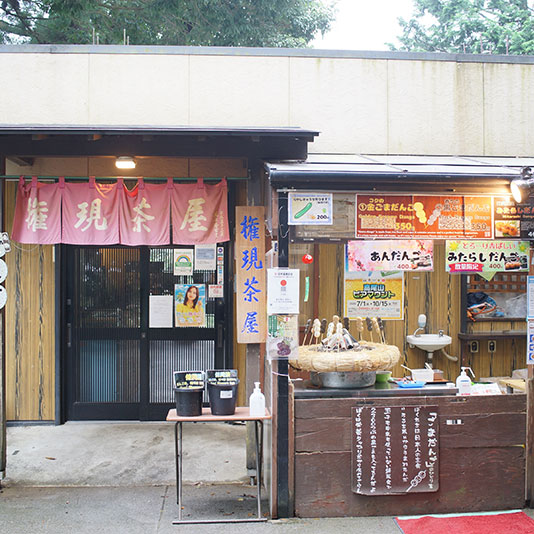
Gomadokoro Gongen Chaya (Café)
- Hachioji City
- Food of the Tama area
“Gomadokoro Gongen Chaya” is a roadside café located along mountain hiking Route 1 of Takao-san Mountain. Because it is in front of Takao-san Yakuo-in Temple, it is always crowded with many customers. The menu is wide-ranging from light meals to sweets, and the popular “Tengu Ramen” provides the same outstanding flavor as a “Zakkoku Tororo-Bo (Millet Tororo Stick)” which is mixed with tororo (yam) and millet and then fried. The ten ingredients (Ten-gu) in the healthy soup with plenty of black sesame go well together. The rich nutritional ingredients and moderate acidity of the soup heal the tiredness of mountain hiking. After eating, we recommend “Goma-dango (Sesame dumplings) with a glutinous texture.
2177 Takao-machi, Hachioji City, Tokyo 193-0844
TEL. 042-661-2361


